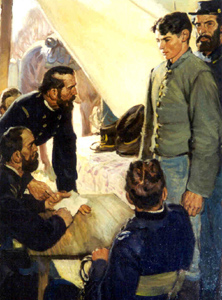
Sam Davis
“Boy Hero of the Confederacy” Sam Davis was born on his family’s farm near Smyrna on October 6, 1842. A frail child, Davis grew up playing on the land around his home and learned the landscape of Middle Tennessee, knowledge that later aided his activities as a Confederate scout. At age nineteen the quiet and refined Davis left home to attend the Military Academy in Nashville. Strict military life suited the idealistic Davis, and at the academy he made the acquaintance of Bushrod Rust Johnson, headmaster of the school and later a Confederate general.
When war fever swept the South, young Davis joined the “Rutherford Rifles,” a local militia group mustered into active service as Company I, First Tennessee Infantry. Davis followed his regiment to Cheat Mountain, in what is now West Virginia, and fought under the command of Robert E. Lee.
In 1862, after his initial enlistment, Davis returned home. That autumn, he joined a company of cavalry known as “Coleman’s Scouts,” commanded by Henry B. Shaw, one of Davis’s former teachers. Numbering around one hundred, the Coleman Scouts operated around Nashville, Franklin, Murfreesboro, and Columbia, gathering information about Federal troop movements. Although considered spies by the Union army, the Scouts usually wore their uniforms and seldom used disguises.
In the fall of 1863 Davis and five others were assigned to gather information about Federal forces in Tennessee. They spent much of their time learning the movements of General Granville Dodge’s division as it passed from northeast Mississippi through Middle Tennessee on its way to Chattanooga. Dodge ordered his men to wipe out the Scouts, if possible.
Moving behind enemy lines and risking capture, Davis returned home to Smyrna in early November 1863. After a brief visit with his family, he left to rejoin the Scouts. On November 19, 1863, while scouting near Pulaski, Davis accepted a letter written to the Provost Marshal of the Army of Tennessee and several newspapers from Captain Shaw to be delivered to army headquarters. The next day, Federal soldiers captured Davis in Giles County, charged him with spying and carrying mails to persons in arms against the United States, and brought him before General Dodge. Davis pleaded not guilty to charge of spying, but entered a guilty plea to the second charge. The court-martial appointed to try Davis found him guilty on both counts and sentenced him to be hanged.
One week after his capture the sentence was carried out. Standing before the noose, he was offered his freedom if he would reveal the name of the person who gave him the papers. His answer, “I would rather die a thousand deaths than betray a friend or be false to duty,” became a touchstone of the mythology of the “Lost Cause” in the postwar South. Monuments to his bravery were erected on the grounds of the State Capitol and on the square in Pulaski. Later, in the 1920s, his family home in Smyrna became a historic house museum and a shrine to Davis, who is buried there in the family cemetery. Pulaski also has a small museum in his honor, dedicated in the 1960s, which stands near the spot of his hanging in the town’s Sam Davis Avenue historic district.



